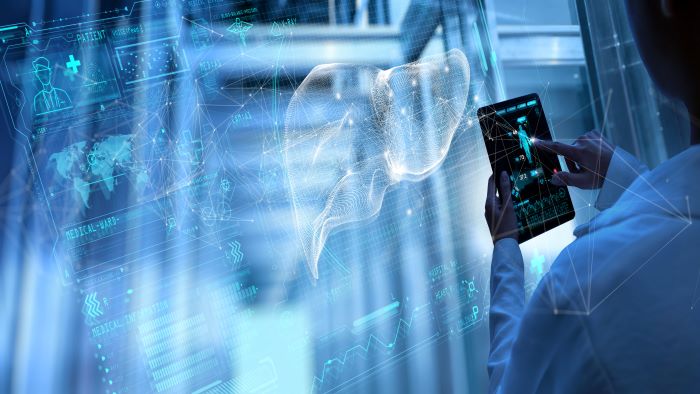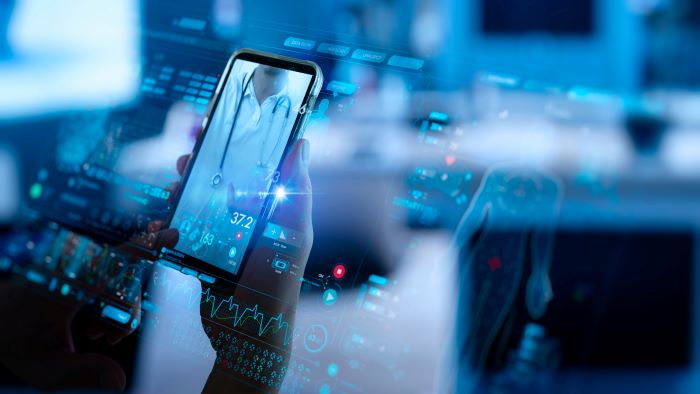Augmenting healthcare in Asia Pacific: AI and data to the rescue?
Jul 20, 2022 - Reading time 7-9 minutes
AI can undertake time-consuming tasks like diagnosis and prediction and help reduce acute emergencies
From diagnosing skin cancer to transcribing clinician notes and automating hospital workflows, artificial intelligence and data analytics tools are enjoying a heyday in healthcare. The maturity and real-world implementation of advanced digital technologies comes at a welcome moment when healthcare systems are battling multiple concurrent challenges including ageing populations and the continual threat of infectious diseases, new and old.
In the Asia Pacific region, public health dynamics are especially daunting. Infectious diseases continue to take a heavy toll. Of the 296 million people with chronic hepatitis B infection, 116 million live in the Western Pacific and 18 million in Southeast Asia. (1) Nearly half of the world’s tuberculosis burden is in South-east Asia. (2) The continent is at the epicentre of the rise of antimicrobial resistance (3) and is vulnerable to climate change (4) and its attendant healthcare risks. At the same time, non-communicable disease (NCD) incidence is growing as populations age and lifestyles change. Nearly half (47%) of all deaths in Asia are attributable to NCDs. (5) Advances in AI and data could, experts hope, help Asia Pacific’s health sectors confront these tidal threats.
AI is just a tool like all the mathematical models that we've been using in the past. The difference is that it can look at more data and have a different angle. Machine learning methods can be trained with beautiful accuracy,”
Dr Denis Bauer
bioinformatics team leader at Australia's national science agency, the Commonwealth Scientific and Industrial Research Organisation (CSIRO)
But “we are still on that journey,” adds Dr Bauer, who is also associate professor at Macquarie University's Department of Biomedical Science. Data governance, interoperability, regulatory evolution, and workforce engagement are just a few of the systems-level reforms needed to make full use of frontier digital technologies.
Augmented intelligence
However, some experts are preferring to frame AI as offering “augmented” rather than artificial intelligence, like Kee Yuan Ngiam, who is group chief technology officer and deputy chief medical information officer at the National University of Health Systems in Singapore. “It acts as a clinician decision support tool to help treat patients,” he says. Deep learning and neural networks can, for instance, model disease progression and make predictions about patients at higher risk. “This could mean a doctor will be alerted to a patient coming into the clinic with an increased risk of breast cancer and would order a mammogram even when the patient is coming in for a completely different [clinical condition],” he says. “This is the dream that we want to achieve - without a clinician even having to click a button or put in new data.”

Tim Shaw, professor of digital health and director of research in implementation science and the e-health group at the University of Sydney in Australia, envisions a bright future in which “clinicians have fingertip-touch access to information about their patient population, their outcomes, how they compare to peers and how care is managed.” That is still a far cry from current realities, though. “At the moment, clinicians are largely flying blind about the care they deliver and the outcomes. I think that's a big revolution we're going to have.”
Prediction is one of the most coveted capabilities that AI and data modelling offers. The CSIRO is applying AI to genomics to spot individuals at risk of heart failure or motor neuron disease, for instance, and for that they had to invent machine learning approaches that can handle high dimensional data, according to Dr Bauer (6). CSIRO also recently completed a trial of smart home sensors to detect changes in older people’s daily activities, helping enable them to remain living in their own homes for longer and for medical intervention in the case of a potential emergency. (7)
In the Singaporean context, Kee Yuan Ngiam thinks AI could provide continuous nudges and support for those with chronic conditions like hypertension to manage their condition through, for instance, timely reminders about medication and the need for blood pressure checks. Singapore’s government has “made a very deliberate investment into AI to ensure that we can leverage AI’s capability to help manage the increase or indeed reduce the incidence of chronic disease in the community”. A cost-benefit analysis makes investing in AI “one of the easiest choices for any government to make”.
While Singapore and Australia are leading markets, AI technologies are reaching patients in lower income geographies. In the Philippines, it has been used to interpret chest X-rays to aid diagnostics during the covid-19 pandemic. (8) In Vietnam, Vinbrain, an AI software company, has developed an AI model for diagnosing and screening TB. (9)
Cost control
By carrying out important but time-consuming tasks like diagnosis and prediction, AI and data science can reduce both the number of acute emergencies (10) , thereby lowering the burden on hospitals (11) , which are a major driver of overall healthcare costs. Other such tools can optimise resource allocation, workflows, and scheduling, further improving the logistics of the hospital sector. (12) “Every 15-minute block of time in an operating theatre costs thousands of dollars,” observes Kee Yuan Ngiam.
Healthcare providers in Singapore are already using cutting-edge technology to optimise services based on population modelling. For instance, Tan Tock Seng Hospital has built an ‘artificial brain’ to assign and prioritise beds, crunching through over 300 rules. This frees up staff to focus on caregiving rather than manual processes and documentation. (13) The newly built Woodlands Health Campus will apply automation, AI, and robotics to everything from diagnosis to logistical management of food, housekeeping, and equipment. (14)
Tech-enabled efficiencies could be a boom to countries in the Asia Pacific region with over-burdened workforces.
In Indonesia, there are less than 100,000 doctors for a population of 260 million, so they [the government] believe AI will increase productivity,”
Dr Hananiel Widjaja
director and co-founder of Kortex Indonesia
The region has too few medical professionals for its vast population: 1.3 physicians per 1,000 people (15) , just within the WHO’s benchmark of 1.15 per 1000. (16)
Healthcare AI: a systems problem
While the proliferation of AI and data technologies in healthcare is a welcome trend, experts continually warn that progress is slow and uneven. The challenge, they argue, is that any individual gadget or tool must be embedded into a wider technological, economic, and cultural context.
AI and digital technology need to be aligned to the workforce. “Our challenge at the moment is that all of the fresh graduates in our hospital system need to be trained with AI and technology for six months, so they cannot handle the patients or work in the hospital before they do the training for that area,” says Dr Widjaja. Singapore is focusing heavily on training and certification programmes that integrate with medical degrees. “We teach students how to go through the entire process of building an AI tool including ethics, guidelines and regulations,” says Kee Yuan Ngiam.
Cost is a constraint, which could lead to deepening inequalities if countries cannot afford upfront investments in technologies. A poll by Hospital Management Asia revealed that only 12% - mainly healthcare executives - were using some sort of AI in their department, although 98% agreed that AI has the potential to transform healthcare and 90% would be open to using it. The reasons were mainly perceived costs (87%) and lack of infrastructure (66%) – whether their IT systems could support the technologies, or the availability of trained personnel to maintain and manage them. (17)
Efficient digital infrastructure - the plumbing allowing data to be gathered, moved, processed, and acted on - will unlock the potential AI has to offer in real world settings.
Amidst the digital revolution, what is missing is smart data integration and sharing for the right reason, at the right time will speed the impact of public policies and healthcare on the lives of people we serve”
Dr Samira Asma
assistant director-general for data, analytics, and delivery for impact at the World Health Organisation

Fragmented data systems became evident during the pandemic. According to Dr Bauer, large tracts of genomic data were collected during the covid-19 pandemic, but the vast majority had no patient information attached, reducing the potential of AI to be used. (18) “What covid has done, in my mind, is really exposed the weaknesses in these processes, forced us to actually need to share data to look at decision support across organisations and we suddenly realised that we really have some fundamental flaws,” says Professor Shaw. But risks can be managed - and the benefits are worth the work. Professor Shaw warns against “sticking our heads in the sand and saying we're just not going to digitise because it's too hard, it's too risky. We would lose all the benefits. It would be like financial services saying we can't risk breaches of financial data and therefore we're going to go back to not having e-banking.” This article has been commissioned by Philips and written by Economist Impact as part of the Asia Pacific Healthcare Redefined program series.
Of course, connectivity creates new risks. Hackers have already entered health infrastructures across multiple contexts and geographies, from the WannaCry attack on the NHS (19) (20) to ransomware attacks in Singapore (21) (22) and nefarious actors could seek to access personal health information for purposes including targeted marketing or blackmail.
Others acknowledge the challenge of balancing individual data protection with appropriate levels of openness and data-sharing. Dr Boonchai Kijsanayotin, chair of the Asia E-Health Information Network, describes “a delicate balance between how much we can [use in the] public good, and how much you protect for privacy. Data shared for marketing, for insurance, that is very dangerous for the individual. If we don't protect that individual privacy or confidentiality, then we cannot build or create attractive systems for sharing data.”
For Professor Shaw, the goal is “flexible consents and variable consent processes to allow people to access and use data.” For the WHO’s Dr Asma, scaling innovation in data and AI can accelerate progress to protect and improve health and save lives. “We are going at about a quarter of the pace to reach the Sustainable Development Goals by 2039. The key is to build sustainable systems. Having clarity of the needs in countries and pairing solutions with trusted governance and equitable digital literacy is going to be crucially important.”
Stay up to date and subscribe
Sign up to stay informed and receive information on healthcare innovation, straight to your inbox
2) https://www.who.int/southeastasia/health-topics/tuberculosis 3) https://www.ncbi.nlm.nih.gov/pmc/articles/PMC3780932/ 4) https://public.wmo.int/en/media/press-release/weather-and-climate-extremes-asia-killed-thousands-displaced-millions-and-cost 5) https://bmcpublichealth.biomedcentral.com/articles/10.1186/s12889-020-08890-4 6) https://academic.oup.com/gigascience/article/9/8/giaa077/5881621 7) https://www.csiro.au/en/research/health-medical/smarter-safer-homes 8) https://opengovasia.com/more-ai-being-deployed-in-the-philippine-healthcare-sector/ 9) https://vinbrain.net/vinbrain-and-fit-co-publishing-a-white-paper-on-ai-applications-in-tb-diagnostics-and-screening- 10) https://onlinelibrary.wiley.com/doi/full/10.1002/ams2.740 11) https://journals.plos.org/plosone/article?id=10.1371/journal.pone.0238118 12) https://www.neuroimaging.theclinics.com/article/S1052-5149(20)30063-0/fulltext 13) https://govinsider.asia/smart-gov/exclusive-tan-tock-seng-hospital-builds-artificial-brain-to-manage-services/ 14) https://govinsider.asia/innovation/woodlands-health-campus-to-use-ai-and-robotics-for-patient-care/ 15) https://www.ncbi.nlm.nih.gov/pmc/articles/PMC6345296/ 16) https://human-resources-health.biomedcentral.com/articles/10.1186/s12960-020-00533-4 17) https://mesfutur.uch.cat/wp-content/uploads/2022/04/InsightPaper_HMA.pdf 18) https://www.sciencedirect.com/science/article/pii/S2001037022002197?via%3Dihub 19) https://www.england.nhs.uk/wp-content/uploads/2018/02/lessons-learned-review-wannacry-ransomware-cyber-attack-cio-review.pdf 20) https://www.ncbi.nlm.nih.gov/pmc/articles/PMC5461132/#6:~:text=On%20May%2012%2C%20the 21) https://techwireasia.com/2021/10/the-cyber-pandemic-continues-in-singapore-with-another-healthcare-data-breach/ 22) https://www.csa.gov.sg/News/Press-Releases/ransomware-incidents-online-scams-and-covid19-related-phishing-activities-dominated-cyber-landscape-in-2020
1) https://www.who.int/news-room/fact-sheets/detail/hepatitis-b
%20%E2%80%9CWannaCry,divert%20ambulances%20to%20other%20facilities








